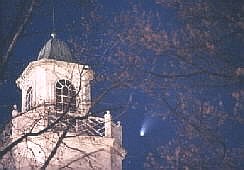Astronomy
Comet Hale-Bopp over Colonial Hall

(photograph by J. Gerencher)
I retired from the Moravian College faculty in 2009, so the pages below describe the astronomy course and the facilities for astronomy only prior to the summer of 2009. Please see the Physics and Earth Science Departmental web site for the current descriptions.
Click here to see the Earth Science classroom.
The catalog description of the Astronomy course read as follows:
Earth Science 130: Astronomy. Methods and results of astronomical exploration of the solar system, our stellar system, galaxies, and the universe; laboratory includes telescope observations, optics, analysis of astronomical photographs, and computer simulations. Two three-hour periods per week.
The syllabus for the course (as a Word document) listed the sequence of topics for the classes, the book used, the equipment needed, and some of the procedures employed during the semester when I last taught the course. All my syllabi in all the courses that I taught during my entire career were printed on both sides of only a single sheet of paper.
Each student was required to complete an individual observation project, selected from a list of several suggested projects, or it may have been a project which the student designs. Near the end of the semester, the results of each individual project were presented orally to the class and submitted to the instructor as a written report.
The videos, films, and animations shown during the semester have links on this page and can be viewed only from networked computers on campus.
There is a telescope platform on the upper roof of Collier Hall of Science. Its position, as determined by the department's Garmin GPS 12 Professional Navigator, using the 1927 map datum, is latitude 40 degrees, 37.792 minutes North, longitude 75 degrees, 22.955 minutes West, and an altitude of 420 feet.
The students enrolled in the course, as well as those formerly enrolled during
the past three years, had access to several telescopes through a check-out key system
which was maintained at the circulation desk of the library. The equipment available
to these students through this system was the following:
two 6-inch Newtonian reflecting telescopes and
a 3-inch refracting telescope.
Additional telescopes were available for group viewing and special projects. They
were
a Four-inch Stellarvue (102ED) refractor
a 12-inch Cave
Optical Newtonian reflecting telescope
a Meade ETX-90EC
Schmidt-Cassegrain telescope
an 8-inch Meade LX-200
Schmidt Cassegrain telescope
the 8-inch Meade LX-200 is housed in a custom-built telescope
enclosure
a 10-inch Meade LX-200 Schmidt Cassegrain telescope
the 10-inch Meade LX-200 is housed in a custom-built telescope enclosure
an 11-inch Celestron Schmidt Cassegrain telescope
In addition, the Department had the following two CCD cameras available:
an SBIG ST-4
an SBIG ST-7
Additional CCD-related equipment included
a Cron-Cousin filter set
a JMI focuser
a flip mirror
All telescopes possessed by the department were equipped with electrical motor drives.
Examples of astrophotographs taken by previous students are included among the photographs listed on my photographic interests page. I have had the pleasure to observe two total solar eclipses, one in 1970 and the other in 1999. In my travels, I have encountered some monuments and tributes to historic astronomers who have received national heroic stature. I have also been to sites of archaeoastronomy.
The following computer programs had been available to all students in the computer classroom
and in the computer laboratory:
Analemma
Astronomer's Digital Clock
Contemporary Laboratory Activities in Astronomy (CLEA)
Astronomy of Asteroids
Photoelectric Photometry of the Pleiades
Radio Astronomy of Pulsars
Classification of Stellar Spectra
Flow of Energy Out of the Sun
Hubble RedShift Distance Relation
Large Scale Structure of the Universe
Revolutions of the Moons of Jupiter
Rotation of Mercury
Search for Object X
Period of Rotation of the Sun
Meridian
Red Shift (CD-ROM required}
Sky Charts
Sun Graph
WinEphem
Astromusic was a Word document that contained the titles of music that had an astronomical theme. The astromusic list was compiled the old-fashioned way -- by individuals looking over their collections of records, tapes, CD's, and digital archives.
A collection of astronomy videos was maintained in the Moravian College library.
Click here for interesting external astronomical web sites.
The Astronomy program has benefited from donations of telescopes and associated equipment.